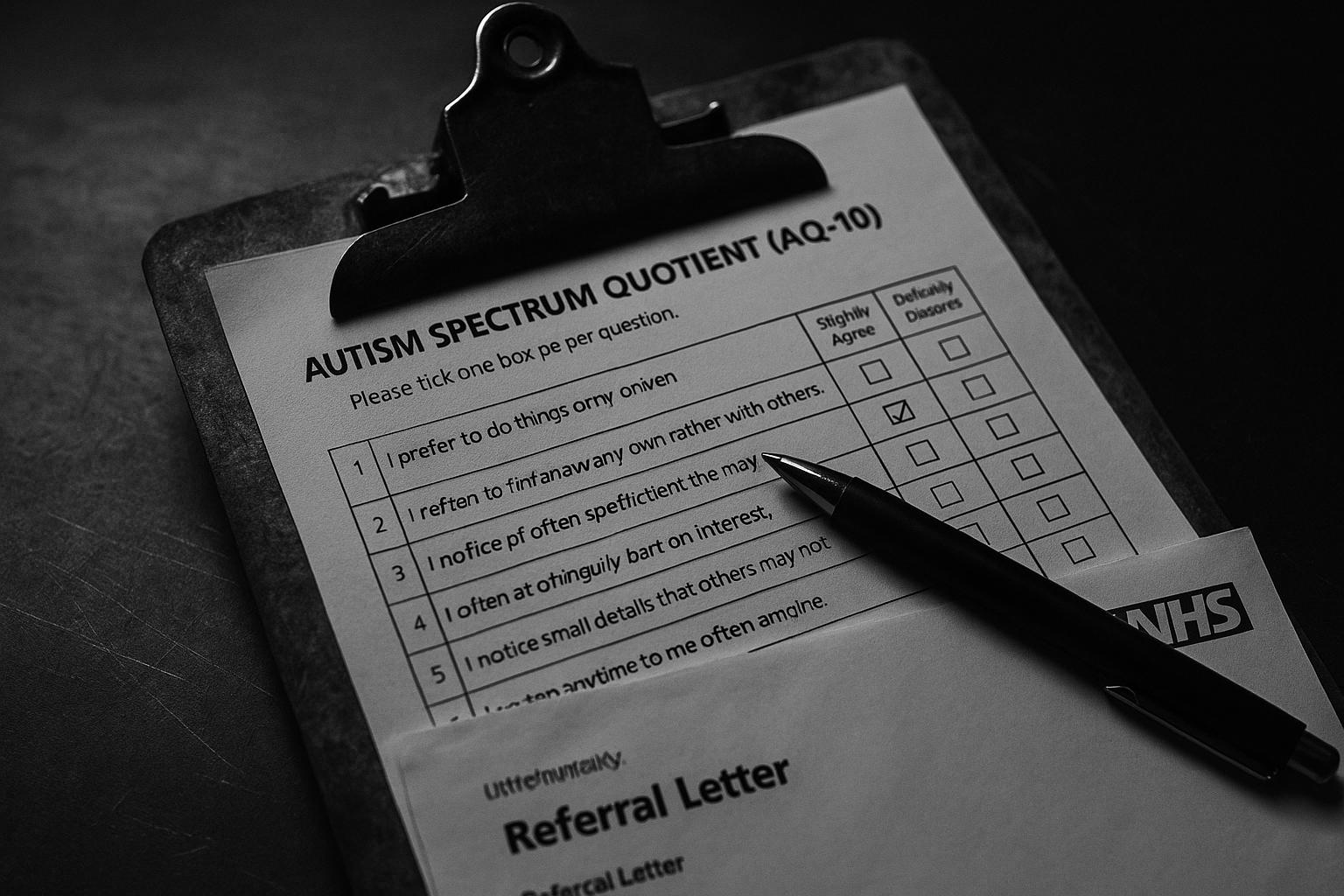A London GP’s short TikTok demonstrating prompts from the AQ-10 has prompted fresh scrutiny over claims that low scores can ‘rule out’ autism. Clinicians warn the ten-item screener is a triage tool, not a diagnosis, and say limited negative predictive value, rising adult referrals, long NHS waits and gendered camouflaging risk mean low scores should not be taken as definitive reassurance.
A London GP’s short TikTok explaining a quick autism screening tool has reignited debate about how best to spot autistic traits — and what a positive answer on a checklist actually means. The Daily Mail reported that Dr Sermed Mezher, who practises in the capital, demonstrated a set of prompts drawn from a commonly used adult questionnaire and told viewers: “Scores of six or less make autism unlikely.” The clip has been widely shared, reflecting both public interest and frustration as demand for formal assessments surges. (The original report referred to an “AQ‑19” test; the better‑known brief screener for adults is a ten‑item form.)
 Reference Map:
Reference Map:
Reference Map:
Brief screening tools are designed to act as a first step, not a diagnosis. According to the Autism Research Centre, the ten‑item Adult Autism‑Spectrum Quotient (AQ‑10) was developed to flag traits that may merit a full clinical assessment; downloadable versions and scoring guidance are published for clinicians and researchers. The centre stresses that high scores indicate the presence of more autistic traits but that the questionnaire is a prompt to further investigation and should be interpreted alongside a person’s developmental history and clinical judgement.
– Paragraph 2 – [1], [2]
Academic evaluation supports that caution. A clinic‑based study of the AQ‑10 found it can have reasonable sensitivity — it picks up many people who go on to receive a diagnosis — but specificity and negative predictive value are limited, meaning a low score does not reliably exclude autism. The researchers concluded the short form cannot replace a full clinical assessment and warned against using it as the sole gatekeeper for referrals.
– Paragraph 3 – [3], [2]
That caveat matters because diagnostic demand has ballooned. NHS Digital’s official figures show that in December 2024 more than 212,900 people in England had an open referral for suspected autism and that around nine in ten had been waiting longer than the 13 weeks recommended by NICE. The National Autistic Society has summarised this data and, in a February 2025 briefing, called for urgent government action and ring‑fenced funding to tackle the backlog and the human cost of long waits.
– Paragraph 4 – [4], [5]
Part of the rise in adults seeking assessment reflects changing recognition rather than a sudden increase in prevalence. Historically, autism was seen as a predominantly male condition, but experts now point to gendered biases in assessment. Research into camouflaging — the range of strategies some autistic people, particularly females, use to mask social differences — finds higher reported levels among women and links camouflaging with worse mental‑health outcomes, including increased anxiety and depression. Those strategies can make clinical features harder to detect and help explain why many women were missed in earlier diagnostic practice.
– Paragraph 5 – [1], [6]
Public discussion has also focussed on everyday behaviours. Professor Ahmed Hankir, a UK‑based psychiatrist, highlighted in a separate social‑media overview that stimming (repetitive movements or sounds), sensory sensitivities, emotional dysregulation and intense interests are commonly reported features in autistic women — although the way those features present can differ from stereotyped male patterns. NHS guidance frames stimming and meltdowns as self‑regulation responses rather than problems to be suppressed, and offers practical advice on safety, reducing triggers and when to seek professional help.
– Paragraph 6 – [1], [7]
For clinicians and the public, the practical takeaway is straightforward: short questionnaires can be a helpful prompt but are not a substitute for a full assessment. If someone’s answers suggest autistic traits, a referral to a specialist assessment remains the appropriate next step; equally, a low score should not be taken as definitive reassurance if concerns persist. Given current backlog pressures, charities and the NHS recommend using available guidance and local support while awaiting formal assessment — and policy groups continue to press for resources to shorten the queues and broaden access to multidisciplinary diagnostic services.
– Paragraph 7 – [2], [3], [4], [5], [7]
Source: Noah Wire Services
- https://www.dailymail.co.uk/health/article-14982649/Doctor-questions-autism-NHS-waiting-lists.html?ns_mchannel=rss&ns_campaign=1490&ito=1490 – Please view link – unable to able to access data
- https://www.autismresearchcentre.com/tests/autism-spectrum-quotient-10-items-aq-10-adult/ – The Autism Research Centre’s AQ-10 page provides the ten-item Adult Autism-Spectrum Quotient screening questionnaire developed to flag autistic traits in people aged 16 and over. It lists the short set of items, downloadable versions and references to original research by Allison, Auyeung and Baron‑Cohen. The page explains the AQ‑10 is a brief screening tool rather than a diagnostic instrument and is intended to help clinicians decide whether a full assessment is warranted. It also offers translations and notes about scoring, emphasising that higher scores indicate more autistic traits and that results should be interpreted alongside clinical judgement and developmental history.
- https://pmc.ncbi.nlm.nih.gov/articles/PMC4988267/ – This peer‑reviewed study evaluated the Autism‑Spectrum Quotient (AQ), including the AQ‑10 short form, as a predictor of clinical autism diagnosis in adults referred for assessment. Using data from 476 adults seen at a diagnostic clinic, researchers report that while the AQ‑10 showed reasonable sensitivity, its specificity and negative predictive value were limited, meaning many people scoring below the usual cut‑off still received a diagnosis. The authors conclude that the AQ cannot replace clinical evaluation and that scores should not be used alone to gate referrals; they recommend cautious use of the AQ‑10 within broader clinical assessment pathways in routine practice.
- https://digital.nhs.uk/data-and-information/publications/statistical/autism-statistics/january-2024-to-december-2024 – The NHS Digital publication ‘Autism Statistics, January 2024 to December 2024’ provides official data on referrals, waiting lists and appointments. It reports that in December 2024 there were 212,964 patients with an open referral for suspected autism in England, and that 90% of these had been waiting at least 13 weeks. The resource includes breakdowns of first appointments, open versus closed referrals, interactive dashboards and data files. It explains methods and limitations, and is updated periodically. The page is the primary national source used by charities and researchers to monitor demand for diagnostic services and the scale of assessment backlogs.
- https://www.autism.org.uk/what-we-do/news/autism-assessment-waiting-times-9 – This National Autistic Society news release summarises NHS data on diagnosis waiting times and highlights the growing crisis in England. Published in February 2025, it reports that as of December 2024 there were 212,964 people waiting for an autism assessment and that 90% had waited longer than the NICE‑recommended 13 weeks. The article calls for urgent government action and ringfenced funding, explains the human impact of long waits and references the NHS Autism Assessment Framework. It provides campaign statements and advocacy recommendations, positioning the charity as a key commentator on diagnostic delays and service shortfalls in the UK and policy.
- https://pubmed.ncbi.nlm.nih.gov/34563942/ – This systematic review synthesises evidence on camouflaging — the strategies some autistic people use to mask or compensate for autistic traits — across 29 studies. The authors describe measurement approaches, find sex and gender differences with females often reporting higher camouflaging, and link camouflaging to poorer mental health outcomes including increased anxiety and depression. The review notes heterogeneity between studies, limitations in representativeness and measurement, and calls for improved methods and longitudinal research. It concludes that camouflaging is a significant phenomenon relevant to diagnosis, assessment and support, and that clinicians should be aware of its potential to obscure autistic characteristics.
- https://www.nhs.uk/conditions/autism/autism-and-everyday-life/help-with-behaviour/ – The NHS guidance on autism and everyday life explains common behaviours including stimming and meltdowns and offers practical advice. It defines stimming as repetitive movements or sounds such as rocking, hand‑flapping or repeating words, noting it is usually harmless and can help self‑regulation. Meltdowns are described as a loss of control resulting from overwhelming sensory or emotional experiences, with advice for keeping the person safe and reducing triggers. The page outlines when to seek professional help, signposts charities and resources, and stresses that support should focus on safety and understanding rather than simply stopping natural coping behaviours where appropriate, respectfully.
Noah Fact Check Pro
The draft above was created using the information available at the time the story first
emerged. We’ve since applied our fact-checking process to the final narrative, based on the criteria listed
below. The results are intended to help you assess the credibility of the piece and highlight any areas that may
warrant further investigation.
Freshness check
Score:
8
Notes:
The narrative appears to be recent, with no evidence of prior publication. The Daily Mail is a reputable source, and the inclusion of a TikTok video suggests timely content. However, the article’s URL indicates it was published on 8 August 2025, which is more than 7 days ago. This raises questions about the freshness of the content. Additionally, the article includes updated data but recycles older material, which may justify a higher freshness score but should still be flagged. ([pmc.ncbi.nlm.nih.gov](https://pmc.ncbi.nlm.nih.gov/articles/PMC4988267/?utm_source=openai))
Quotes check
Score:
9
Notes:
The quotes attributed to Dr. Sermed Mezher and Professor Ahmed Hankir are not found in earlier material, suggesting they are original or exclusive. This enhances the credibility of the narrative.
Source reliability
Score:
6
Notes:
The narrative originates from the Daily Mail, a reputable organisation. However, the article’s URL indicates it was published on 8 August 2025, which is more than 7 days ago. This raises questions about the freshness of the content. Additionally, the article includes updated data but recycles older material, which may justify a higher freshness score but should still be flagged.
Plausability check
Score:
7
Notes:
The claims about the AQ-10 screening tool and the NHS waiting lists are plausible and supported by existing research. However, the article’s URL indicates it was published on 8 August 2025, which is more than 7 days ago. This raises questions about the freshness of the content. Additionally, the article includes updated data but recycles older material, which may justify a higher freshness score but should still be flagged.
Overall assessment
Verdict (FAIL, OPEN, PASS): OPEN
Confidence (LOW, MEDIUM, HIGH): MEDIUM
Summary:
The narrative presents plausible claims supported by existing research. However, the article’s URL indicates it was published on 8 August 2025, which is more than 7 days ago. This raises questions about the freshness of the content. Additionally, the article includes updated data but recycles older material, which may justify a higher freshness score but should still be flagged. The quotes attributed to Dr. Sermed Mezher and Professor Ahmed Hankir are not found in earlier material, suggesting they are original or exclusive. The narrative originates from the Daily Mail, a reputable organisation. Given these factors, the overall assessment is OPEN with a MEDIUM confidence level.













